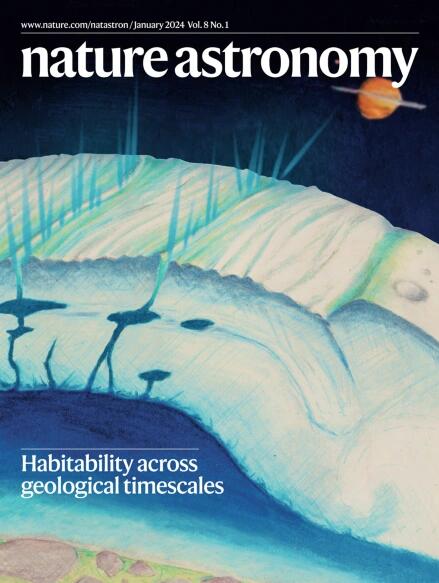一个新活跃黑洞的准周期性喷发
IF 14.3
1区 物理与天体物理
Q1 ASTRONOMY & ASTROPHYSICS
引用次数: 0
摘要
2024年,一个星系核开始周期性地发射x射线。这些准周期性喷发的通量和时间尺度是迄今为止探测到的最高的,被认为是由超大质量黑洞新形成的吸积流引起的。本文章由计算机程序翻译,如有差异,请以英文原文为准。

Quasi-periodic eruptions from a newly active black hole
A galactic nucleus began emitting X-rays, periodically, in 2024. These quasi-periodic eruptions have the highest fluxes and longest timescales of any detected so far, and are thought to originate from newly formed accretion flows onto a supermassive black hole.
求助全文
通过发布文献求助,成功后即可免费获取论文全文。
去求助
来源期刊

Nature Astronomy
Physics and Astronomy-Astronomy and Astrophysics
CiteScore
19.50
自引率
2.80%
发文量
252
期刊介绍:
Nature Astronomy, the oldest science, has played a significant role in the history of Nature. Throughout the years, pioneering discoveries such as the first quasar, exoplanet, and understanding of spiral nebulae have been reported in the journal. With the introduction of Nature Astronomy, the field now receives expanded coverage, welcoming research in astronomy, astrophysics, and planetary science. The primary objective is to encourage closer collaboration among researchers in these related areas.
Similar to other journals under the Nature brand, Nature Astronomy boasts a devoted team of professional editors, ensuring fairness and rigorous peer-review processes. The journal maintains high standards in copy-editing and production, ensuring timely publication and editorial independence.
In addition to original research, Nature Astronomy publishes a wide range of content, including Comments, Reviews, News and Views, Features, and Correspondence. This diverse collection covers various disciplines within astronomy and includes contributions from a diverse range of voices.
 求助内容:
求助内容: 应助结果提醒方式:
应助结果提醒方式:


